K is for Knots, crinkles and plot holes
I had to get a little creative choosing my subject for today, K is such a difficult letter to find a topic to write about, so I thought it would be a good idea to look at some of what I do as a developmental editor and offer suggestions on how to avoid some common pitfalls surrounding plots and inconsistencies.
What does a developmental editor do?
Developmental editing is one of the earliest stages that a writer might wish to engage a professional editor. Some authors will hire a developmental editor with little more than a premise, some after they have written their outline (although these usually fall under the coaching or mentoring umbrella), and others still after they’ve written and self-edited their story until they’re sick of the sight of it. The latter scenario is more common for me, although I have helped one or two clients with an outline.
The role of a developmental editor is to assess the ‘big picture’. When I get a manuscript in for editing, I’m looking for several elements including, but not limited to:
- Good structure – a beginning, middle, and end, with lots of rising action (conflict) and a satisfactory climax.
- A solid plot without pacing issues and with a logical flow (even non-linear timelines)
- Realistic settings (regardless of what galaxy your story takes place in).
- Good characterisation, interaction, and dialogue, as well as observing the ratio between narration and dialogue.
- An assessment of the author’s writing style.
Most of all, I’m looking to see if your story works. I examine how close I feel to your story, if I had an emotional bond with your characters or if they bored me to tears. Did your setting feel real or resemble a paper cut-out?
After I’ve done all this (over two reads, one edit, and with an editorial letter – report – thrown in for good measure), I pass the manuscript back to the author and leave them to peruse my advice in their own time. Often, several emails or private messages are exchanged to whip some of the more resistant characters or scenes into shape, but I encourage that. I’d rather a client contacted me to talk something through than sit in front of their monitor and worry about it, or worse, be put off.
** I should point out (as the above sounds like a sales spiel) that the author always has the final say in what goes into and is discarded from their book.
Avoiding the pitfalls
So, you’ve finished writing your manuscript and you’re eager to get stuck into editing, prior to hiring a developmental editor. Listed below are some techniques you can employ to prevent knots, crinkles, and plot holes.
Do absolutely nothing
Yes, you did hear me right. Put your manuscript away in a drawer and leave it there for as long as you can bear it – a few months at the very least. What this very important but often overlooked step is trying to achieve is distance. The more distant you are from your writing, the more errors and inconsistencies you will see, and the only way to achieve this is to not look at your book.
I often hear: ‘why didn’t I see that?‘ or ‘I can’t believe I missed that’.
The reason I pick out inconsistencies with relative ease is that I haven’t been staring at your manuscript for weeks, or months, on end. I have ‘fresh eyes’, which allows me to dazzle you with my observation skills (though I have no chance of picking them out of my own writing because… yes, I’ve been staring at it for months on end).
So, after you’ve gained sufficient distance (you can distract yourself by writing another book), it’s time to dust the manuscript down and read it straight through. As you read, make notes on what works and what doesn’t, but don’t edit it just yet, and see if you can answer the following questions:
- Is my story interesting?
- Are my settings/scenarios realistic?
- Does my story flow, or drag?
- Are there any scenes that make no sense?
- Do I like my characters?
- Does the dialogue sound realistic?
- What was I thinking? <<<< This is the one I often ask myself and is not a reflection on your writing.
What you are trying to do here is get a sense of how a reader might feel if they were to pick it up. As tempting as it is to tweak the text, try not to. This stage is about garnering an overall impression of the ‘bigger picture’.
Create a Stylesheet
A style sheet is of particular use to authors writing a series. It keeps a brief record of ‘facts’, such as hair and eye colour, whether the right or left arm is missing, or if the jewel that saves the world is a ruby or emerald. They are also useful for specific spellings. You might decide to spell ‘magic’ as ‘magick’ in book one through five, and for reasons unknown, can’t remember how you spelled it when starting book six, or if it was capitalised or not. Rather than hunt for the file on your hard drive, and then search for the word, all you have to do is check your stylesheet (which, between you and your editor, will be fully up to date). I would highly recommend using it for hyphenated words, thus ensuring spelling consistency throughout.
** The punctuation/grammar section would be for your copy editor to use/complete, to record decisions and ensure book consistency. This is especially useful if you change copy editors.
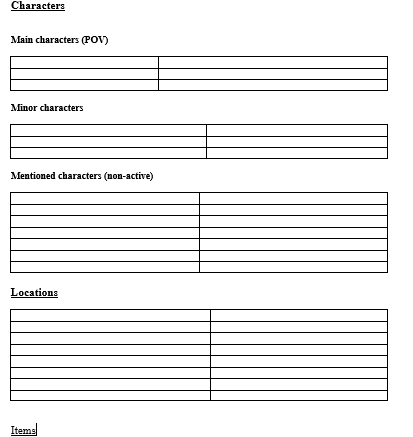
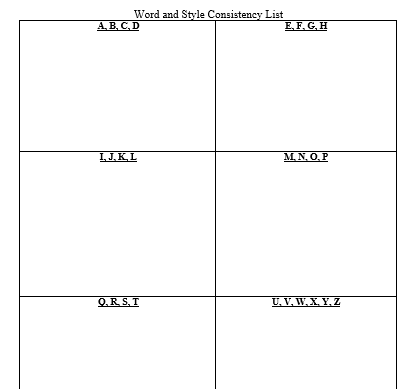
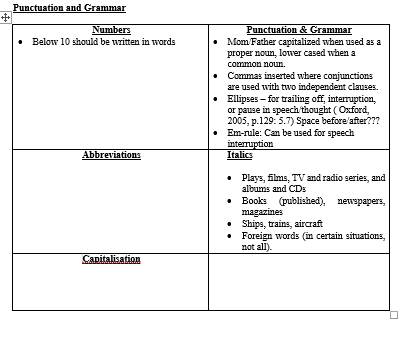
Click here to download the stylesheet
(Docx file. Downloadable)
Use writing software
You may, of course, use writing (planning) software to record the finer details. Scrivener is perhaps the better-known one. I, however, use Ywriter (which is free).
After I have completed my first read, I record the details like so (using a sample story I made up):


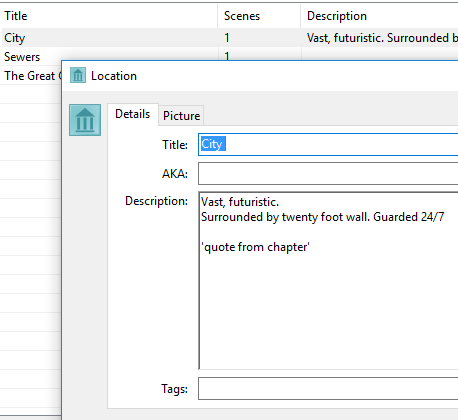

What I am doing here is recording details (amongst other things) and then, in the event that I need to check a hair colour, or a lost limb, I can simply check my notes. If I see a discrepancy, I check back through the manuscript (as I record the actual text, so I can do a quick search in Word if need be) and voila – the inconsistency is located and a note is made on the document or editorial report for the author to either rectify it or sew up a potential plot hole.
I’ve written about Ywriter before, so I won’t repeat myself. If you are interested in reading more about how I use it, you can find the post here: http://michelledunbar.co.uk/ywriter-for-developmental-editing/
After you have worked through the ‘big picture’ elements, put it away again to retain the distance you need for the next edit. I won’t go into that here as I think this post is quite long enough. I hope it gives you a little insight into what I do and my approach. Some authors prefer to edit the text before they tackle the story. Personally, I don’t see the point if you’re going to make any major changes, but each to their own. You have to find the method that works best for you.
Incidentally, I always take a rest period between my first read and the second read/edit, which is why everyone I edit for has a contract lasting at least one month. It doesn’t actually take me a month to edit, but I need that time in between to mull things over and keep a distance.
Anyway, I’m going to end this with a link to a book on self-editing that I have read and am more than happy to recommend:
Fix your Damn Book
This is a very informative book, worthy of a straight read through it, but as it is the kind of book you might want to dip in and out of, I would recommend purchasing the paperback version.
Fix Your Damn Book! will guide you through:
– The seven essential components of successful editing
– Getting into the right headspace to edit your own work
– Objectively diagnosing problems in your manuscript
– The secrets of developmental editing and line editing
– Hacks for sharpening your story, character, and dialogue
– Grammar, spelling, punctuation, passive voice and tense
– Recruiting and making the most out of your first readers
– Proofreading and publishing your finished book

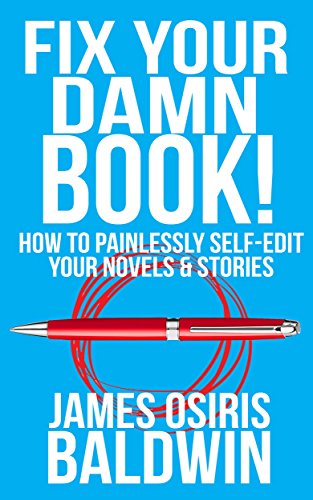
Excellent advice as always, i’m not at the editing stage yet, still got to bully my protagonist into telling me her story, but i will definitely be using this advice when i do get there. I can recommend Scrivener though, i find it helps brilliantly with the planning and organisation of files/chapters etc, but as you say, Writer is free (i’d not heard of it before i got Scrivener).
A great blog, Michelle. I particularly like the idea of a style sheet.